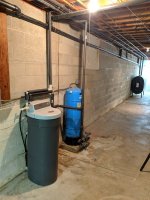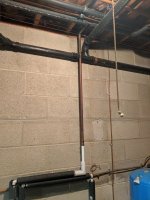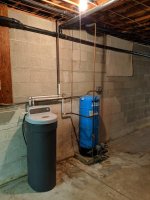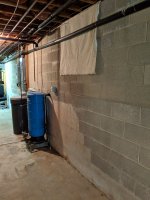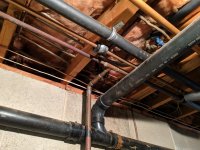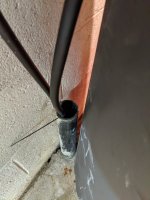kelchm
New Member
Hi all,
I have a couple small plumbing projects I'm planning to tackle this summer:
Things I'm wondering about:
I have a couple small plumbing projects I'm planning to tackle this summer:
- Install a hybrid heat pump water heater in a new location to replace my 24 year old electric water heater. Current energy consumption of my water heater is about $260 per year and accounts for about 12-14% of my overall electrical usage on a monthly basis. Relocating it would eliminate 30+ ft of 1/2" copper pipe from the outlet of the current water heater (a now decommissioned boiler room) and all points of use. I plan to locate it about 8ft to the right of the well pump, immediately to the right of the crawl space access hole in the photos (covered with canvas).
- Relocate water softener to the right hand side of my well pump to get it further away from my electrical panel.
- Install a small PEX distribution block plumber prior to the water softener and run PEX to all existing exterior spigots and at least one new exterior spigot. Currently one of the existing spigots receives softened water.
Things I'm wondering about:
- How can I determine how much dehumidification I can expect from a heat pump water heater? Part of my payback calculation involves reducing the run time of the dehumidifier I currently have in the basement. During the Spring/Summer it's costing me around $0.90 a day to run the dehumidifier alone, which adds up pretty quickly over several years.
- Does anyone have experience with the Rheem hybrid units? I've heard that there have been some issues with the control boards, but otherwise have been fairly reliable.
- Any thoughts on sizing a heat pump water heater? Currently have a 50 gallon electric water heater which serves our needs 95% of the time. The exception would be back to back showers while also running the dishwasher and washer. I'm debating between the 65 and 80 gallon sizes and what impact that may have on the efficiency we end up seeing from it.
- The mess of 90 bends on the water softener plumbing is obviously needlessly restrictive. Beyond eliminating as many of those as I can when plumbing everything back in, is there anything else I should be doing to evaluate the correct sizing of all the supply lines (particularly for things like what size to run to the PEX distribution block prior to the water softener, if I end up using one) to get consistent water pressure? I definitely have issues with hot water pressure currently when running the washer in addition to the shower.
- Is there any reason I can't drain the condensate and PRV from the water heater into the same drain that the water softener currently uses? I assume this feeds into the the same drain system as the floor drains in the basement slab, but have not yet verified that assumption.
- Is it worth the extra material cost and effort for me to learn to work with copper? I'm not entirely convinced that any kind of plastic can ever be as long lived or healthy/safe as copper has proven to be, but then again I guess it makes perfect sense to use for things like exterior spigots.
- Other than following the manufacturer's instructions when installing the water heater (like installing an expansion tank on the outlet side), is there anything I should be researching now while in the planning stage?
Attachments
Last edited:

